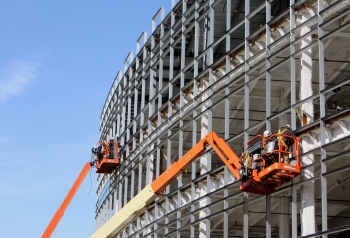Construction Focus of the Month: Fall Protection
Fall Protection Systems in Boom and Scissor Lifts

Enter scissor lifts and boom lifts; convenient platforms that provide our employees a more stable, safer surface from which they can work. Scissor lifts have built in fall protection from the guard rails that are part of the working platform. The rails prevent employees from falling over the edge as long as they are used properly. Employees who are properly trained are less likely to engage in unsafe work practices, like climbing over the rails, or standing on them while they work.
OSHA does allow for additional fall protection on scissor lifts, which some sites require, by referencing ANSI standard A92.6-2006 that states “If occupant(s) of the platform are required to wear personal fall protection equipment (PFPE), occupants shall comply with instructions provided by the [manufacturer]”. In the operator’s manual for Skyjack’s Model SJIII 4740, Skyjack “recommends the use of a fall restraint system to keep an occupant within the confines of the platform, and thus not expose the occupant to any fall hazard requiring a fall arrest”. The fall restraint system uses a positioning lanyard connected to the lift’s attachment point that physically restrains the employee from moving farther than the length of the lanyard allows and prevents employees from leaving the basket or falling from it. On the other hand, it will restrict the employee’s movement and make some tasks more difficult. This may also force employees to stop work to reposition the lift to complete work they couldn’t initially reach. If you need additional fall protection for workers in scissor lifts, then, travel restraint systems using positioning lanyards affords additional fall protection. Other forms of fall protection are not allowed in scissor lifts, as the force of an employee falling out of one could potentially cause a scissor lift to topple. Therefore, it is not a suitable anchor to arrest an employee’s fall using a personal fall arrest system with a deceleration device.
Employees working on boom lifts must be tied off 100% of the time. One option is a positioning lanyard that can be connected to the lift’s attachment point, providing the same functionality as it does on a scissor lift. A retractable lanyard can also be used. It allows employees to move more freely than they can with a positioning lanyard, and can prevent them from falling. Another option is the personal fall arrest system with a fall arrest lanyard. This option restricts employee movement the least, and so allows employees to accomplish more. It does not prevent an employee from falling though, instead preventing them from striking surfaces below. It does require proper planning and setup for the fall hazards, and must be evaluated for each situation.
To ensure your employees have the necessary fall protection, systems must be evaluated one lanyard at a time to decide which one offers the protection that your employees need. Positioning and retractable lanyards clearly have the advantage of being able to prevent a fall from happening; however, they may restrict employee movement too much to be feasible in all situations. Retractable lanyards can lock suddenly and cause soft tissue injuries to employees, especially if they engage while an employee is twisting at the waist. Some also consider the attachment points on baskets and lifts to be an issue, as well. OSHA regulations require an anchor point capable of withstanding 5,000 lbs. per attached employee, whereas the attachment points in baskets and lifts are usually only rated to 1,500 lbs.
Like all aspects of safety, there is no one-size-fits-all solution for fall protection systems, even within one company’s safety program. Each situation much be evaluated to ensure the protection we provide our workers is adequate for the potential hazards they face. By planning carefully, training our employees well, and reviewing our programs as conditions change, we make important strides in ensuring that every worker is valued and safe.







